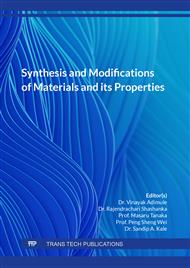p.35
p.47
p.59
p.71
p.85
p.91
p.101
p.107
p.113
Effect of Alloying Elements on Strengthening Phase and Solidification Structure of Ti-Al-Mo-Zr Titanium Alloy
Abstract:
This paper mainly studies the composition of strengthening phase, characteristic precipitation temperature and composition range of strengthening phase in Ti-Al-Mo-Zr-Si medical titanium alloy, and the influence of element changes on the content and microstructure of strengthening phase. Promote the formulation of thermodynamic process of titanium alloy powder metallurgy, as well as the formulation of alloy hot working and solid solution aging process. In this paper, Panda thermodynamic software is used to calculate the multicomponent alloy thermodynamics and multicomponent phase diagram of titanium alloy materials. The effects of Al, Mo, Zr, Si and other elements on the precipitation of strengthening phase and the phase transformation content of solidification structure were obtained. It is found that the content of Mo is more than 2 wt.% β phase transition precipitation angle. Meanwhile, in order to avoid the excess of precipitates such as Mo5Si3 and M3Si, the content of Mo should be less than 4.6 wt.%. The content of Zr can be maintained at about 1.5 wt.%. If the aging precipitation of the material is considered, it can be controlled to be less than 2 wt.%. The content of this paper is the basis and improvement of titanium powder metallurgy technology and rapid prototyping technology.
Info:
Periodical:
Pages:
107-112
Citation:
Online since:
August 2022
Authors:
Price:
Сopyright:
© 2022 Trans Tech Publications Ltd. All Rights Reserved
Share:
Citation:



